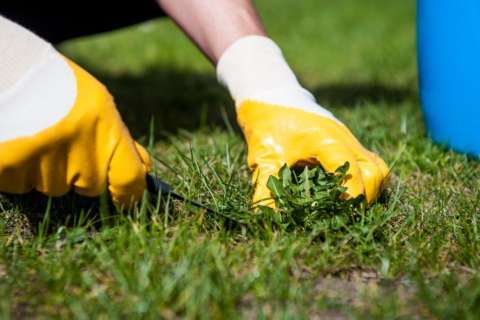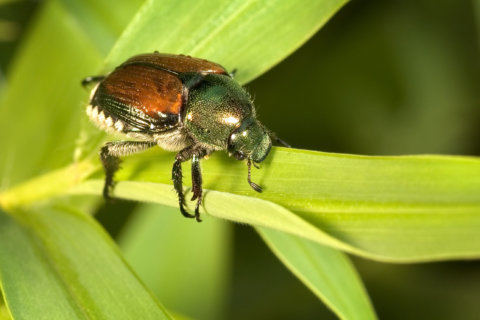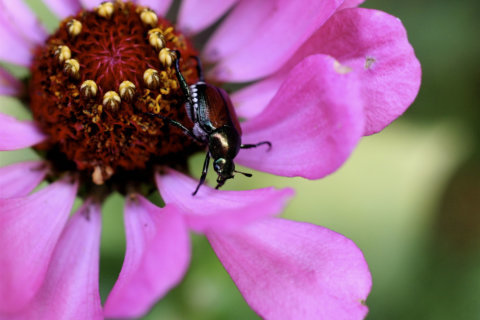Editor’s note: Mike McGrath is on vacation. This week’s Garden Plot was first published on Sept. 14, 2018.
Don’t lime a lawn with a pitch perfect pH!
Tony in Fairfax writes: “I had my lawn aerated and seeded yesterday. I’ll spread Leafgro compost as my next step and be sure to water every day. Local nursery says I should apply lime now as well, since it would have the advantage of penetrating the aerated holes. My soil pH ranges between 6.0 and 7.0. Do you think I should do the liming now?”
No, Tony; your lawn doesn’t need any lime, as your pH — a measure of your soil’s acidity or alkalinity — is already perfect. In his classic book on lawn care (simply titled “Lawns”), Iowa State Turfgrass Professor Dr. Nick Christians states that “the ideal soil pH for growing a lawn is 6 to 7; the most elements and nutrients are available in that range.”
So don’t mess up a good thing!
Comedy is easy; peaches are hard
Jeremy in Chantilly writes: “I planted a peach tree in the backyard about four years ago. Got great fruits, sweet and juicy for a couple of years. This past season, I had to throw away all the peaches due to worm infestation. I did spray a few times when it flowered and when the fruits were small, but nothing after that. What can I do differently to enjoy some fruit?”
Work, work and more work, Jeremy.
Peach trees must be pruned for airflow every year in the late winter/early spring. Then at least half of the developing fruits must be removed while they’re the size of a marble to ensure that the remaining fruits can reach full size. And yes, peaches must also be “sprayed” — but not randomly, and not with poisons.
The best way to protect developing peaches is with a micronized clay spray like Surround. It’ll keep your “worms” (actually small pest caterpillars) away and keep disease at bay.
Fresh peaches are pure pleasure, but they require a lot of work.
Milorganite is not legal for use on local lawns
Charles in Laurel writes, “I am planning on aerating and overseeding my lawn. Is it OK to apply Milorganite as a cover and feed for the new seed? It’s supposed to be an organic fertilizer.”
Milorganite is a highly controversial product, Charles; it’s essentially dried human waste from the sewers of Milwaukee. Because it is only dried and not composted; and because people pour all kinds of nasty things into the sewers, Milorganite is not approved for use in organic food production.
And because it contains phosphorus (the NPK numbers on the label are 5-2-0), it is not legal for use on lawns in Maryland or Virginia, where new laws designed to protect the Chesapeake Bay prohibit the use of fertilizers containing phosphorus.
Use a home grown yard-waste compost like Maryland’s own Leafgro instead.
Garlic planting: rotate your cloves
Clemencia in Potomac writes: “I heard you say that if you only plant garlic cloves harvested from your own garden, you’ll eventually create a variety adapted for your specific conditions. Does this mean that I can plant garlic in the same bed every year and don’t need to worry about rotating it to different parts of the garden?”
“No” to your second question, Clemencia. After using the same beds for my own garlic year after year I started to get a little neck rot — and the garlic didn’t look too good either. (Ba-dump!) So now I plant my cloves in a different bed at the end of each season, and I don’t return to a bed until it’s been garlic-free for three years.
The answer to your first question is “yes!” If you continually select the best cloves from your summer harvest and plant them in the fall, you’ll eventually develop a unique strain that thrives in your specific conditions. After ten years or so, you can even give it a name, like Potomac Purple!
And a reminder: Prime garlic planting time is right now!
Honey do — and don’t; Your end of summer checklist
- Do you need to seed a new cool-season lawn of bluegrass or fescue — or overseed an existing one? Time’s a wasting! Right now, the soil is still warm enough for fast germination, and winter is far enough away that the new grass should be strong and well-rooted before any serious cold weather arrives.
- Whatever you do, don’t wait for spring — cool season grass seed sown in the spring always does poorly.
- We’re in the middle of the perfect window for planting garlic cloves, pansies and new trees and shrubs — and to sow the seeds of lettuce, spinach and other salad greens, which always taste best when grown in the cool air of fall.
- But do not plant any spring bulbs yet — it’s still much too early in the season to put new daffodils, tulips and such in the ground. Keep the bulbs in a cool dry spot and plant them after Halloween.
Mike McGrath was Editor-in-Chief of ORGANIC GARDENING magazine from 1990 through 1997. He has been the host of the nationally syndicated Public Radio show “You Bet Your Garden” since 1998 and Garden Editor for WTOP since 1999. Send him your garden or pest control questions at MikeMcG@PTD.net.







